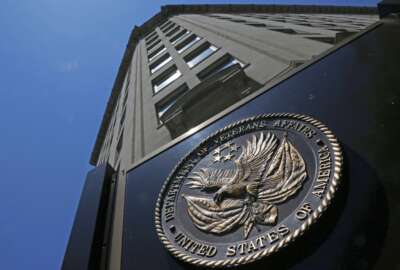Veterans get help trying to navigate Veterans Affairs’ complex of programs
The Veterans Affairs Department operates a vast array of programs, but they can be tricky to navigate for veterans who were not initially eligible.
The Veterans Affairs Department operates a vast array of programs for its constituents. Sometimes they can be a little tricky to navigate, especially for veterans who were not initially eligible. For more, the Federal Drive with Tom Temin spoke with the staff attorney with the National Veterans Legal Services Program, Abigail Reynolds.
Interview Transcript:
Tom Temin And I want to talk about discharge upgrades, because people that have been upgraded to eligibility for VA programs might have figured, well, I’m never going to get them, so I’m not going to look into them and need to know what they are. What’s your sense? And I know your organization helps people apply for upgrades. Is this one out of 100,000 or is it a fairly big piece of machinery, the apparatus for veteran discharge upgrades each year?
Abigail Reynolds Yeah, it’s a great question. There are thousands of people that apply every year for discharge upgrades. So, these boards that review them are seeing tons of applications. They’re reviewing a ton of applications. Sometimes I think that the success rate really depends on the facts of the case. So then in NVLP’s program, we will review every single case to determine if there is a good argument. Usually, we’re looking for things like mental health conditions that might have existed during the Veterans service, traumatic brain injuries, instances of sexual assault or sexual harassment that might have impacted their behavior. And then we will help veterans apply for a discharge upgrade, arguing that those conditions mitigate the misconduct that they excuse kind of what happened that led to the less than honorable characterization. And the military kind of has a history of not doing a great job of taking care of service members who suffer from those mental health conditions. So, it’s pretty common for a veteran who perhaps developed PTSD from combat to commit some kind of misconduct and then get kicked out of the military with a less than honorable discharge. And then now they don’t have access to benefits. So, the mechanism to be able to do that with these review boards, to get that discharge upgraded is really impactful and can really change a lot of lives.
Tom Temin And are there some sort of set of criteria, objective criteria operated by VA such as yes, you did suffer sexual abuse or something like that that they use as a yardstick to measure the applications.
Abigail Reynolds Sure. So, the review boards for these applications are actually located within the DoD, Department of Defense. They make changes to the actual official military record, which is something that the VA doesn’t have the authority to do. So that’s kind of the difference of these review boards and really what they’re looking for. They’re reviewing applications under our standards of kind of overall inequities or injustices in the record. And that is where we see a lot of applications be granted, is where we have evidence of these mental health conditions or survivors of sexual trauma, that those conditions mitigate their misconduct. And that speaks to the overall kind of equity of the discharge characterization. We kind of make the arguments that it’s not really fair for them to be punished this harshly when they have these conditions. So those are kind of the criteria that they’re looking for, those overall injustices or overall kind of unfairness in the discharge characterization, usually based on, again, those kind of mental health conditions from sexual trauma, those kinds of things.
Tom Temin And Veterans Affairs has no discretion to be able to give benefits to someone, even if they arrive with an under upgraded discharge.
Abigail Reynolds So the Veterans Affairs or Department of Veterans Affairs does have the ability they can review discharges and find someone’s discharge honorable for VA purposes. But the only thing that does it makes them eligible for benefits of the VA. But it doesn’t give them new paperwork. So, when they get a new discharge or an upgraded discharge from one of these review boards, they have a new discharge certificate. They take that with them everywhere. So, it’s much more broad and in the impact from these review boards than it is from the VA. And the VA also often doesn’t do a great job at actually reviewing the facts and circumstances. We see plenty of veterans that we work with that have very strong discharge upgrade arguments that have tried to go get benefits at the VA, and theoretically, under those regulations that the VA is reviewing under, they should be able to access them because of their mental health conditions, because of the trauma that they experienced. But often they are denied by the VA and for years have not been able to access those, even if maybe they should have been.
Tom Temin So the best course is to get that upgrade.
Abigail Reynolds Yeah, the upgrade is much more far reaching. Like I said, the board in those cases issues a brand-new discharge certificate. The old one is voided out in their record. It is no longer valid. So, they’re able to use that going forward, not only for VA benefits, but also for other things like using it for employment, using it to apply to educational institutions, those kinds of things. The impact of that characterization goes a lot further when you get the paperwork.
Tom Temin We’re speaking with Abigail Reynolds. She’s a staff attorney with the National Veterans Legal Services Program and the NVLSP. He also has published a detailed guide to the programs that are coming from VA for those that are eligible for them. Why did you feel the need to publish a guide? Is it that hard to figure out what you can get out of VA? Just going to Veterans Affairs Office or VA.gov.
Abigail Reynolds Yeah, it definitely can be. So really kind of the motivation behind us creating this guide was we assist veterans with discharge upgrades. That is kind of what our program focuses on. But after the discharge upgrade is received, there’s a whole host of benefits that’s now available. And we were getting questions from a lot of our veterans that we worked with about, what do I do now? Now that I have this upgraded discharge, what can I apply for? What can I get from the VA? And kind of feeling overwhelmed because there are a lot of benefits that now, maybe for decades they hadn’t been able to access. Now they are. And so, we created this manual in an attempt to have a resource for these veterans when they receive that upgrade, so that they have kind of a one stop shop to see all of the common VA benefits that people might apply for. The things that they might want to consider that they haven’t been eligible for in the past, and kind of have that all in one place because, you know, you mentioned it is all available on va.gov. You can go there and search for the specific benefit that you’re looking for. But if you don’t know what you might want to apply for, then you are going to not even look for it. So the manual is really intended to be a resource that compiles all that information in one place, so that you can take a look through and see what might apply to you, what might benefit you in your life, and then you’re able to kind of use those links directly from the manual to the VA website to figure out the application process and submit that application. So yeah, it’s intended to really just be a compilation so that the information is all available and easier to access. That’s really kind of the goal for us.
Tom Temin And in working with veterans, what’s your sense of how well prepared they are to navigate all of this? Because there is supposed to be mustering out training coming from the Defense Department before people do leave.
Abigail Reynolds So my sense is from mostly veterans who received less than honorable discharge characterizations when they left the military. They often aren’t aware of these processes. There are processes by which the DoD is supposed to kind of be informing them of the benefits that they’re eligible for when they leave, but if they have a less than honorable characterization, they might not actually be eligible for it. So, they might not get told, or they might not be in a headspace where they’re able to kind of process that information because they’ve been through this discharge process that is often really pretty difficult for them to deal with. So, I think that in general, they do find the process of the benefits that can be very overwhelming. There are a lot of different eligibility requirements, even just to be able to apply for the benefit, much less actually be granted the benefit. So I think that we’ve created the manual because we saw so many questions coming through of really being concerned about not knowing what to do now that they have the upgraded discharge and how to get to those benefits that they were wanting, or that they might have applied for a discharge upgrade specifically to access those benefits, and then they just don’t know. They’re kind of overwhelmed by the process and the amount of information that there is. So, I definitely think that that was our motivation in creating the manual as a guide for them. And yeah, I think the administrative process in general can be overwhelming, and the veterans are thankful for any kind of help and guidance they have there.
Tom Temin All right. Abigail Reynolds is staff attorney with the National Veteran Legal Services Program. Thanks so much for joining me.
Abigail Reynolds Thank you so much for having me on. It’s great to speak to you, and we hope that this manual is helpful resource for veterans who have just gotten their discharges upgraded.
Copyright © 2025 Federal News Network. All rights reserved. This website is not intended for users located within the European Economic Area.
Tom Temin is host of the Federal Drive and has been providing insight on federal technology and management issues for more than 30 years.
Follow @tteminWFED






